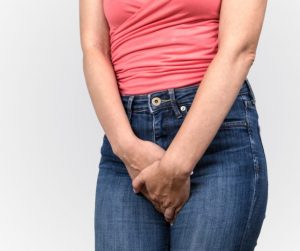
Heading out on your morning jog used to seem effortless. Your legs were strong. You never had to worry about leaking while you ran. But times have changed. Now you leak just a little when you run. It’s embarrassing. You know where all of the bathrooms are and are never far away from one. Or, you may even have to wear a pad, just in case. It’s not just running either. You experience leaking when lifting weights, playing with your kids, or during everyday activities.
It’s hard to admit that our bodies don’t always function the way we would like them to. It’s hard to admit that we leak urine at times. Maybe you have heard your mothers, grandmothers, and aunts talking about it. Perhaps you thought it would never happen to you.
Leaking, while common, is not normal. Frequent urinary leaking is considered incontinence. There are many reasons that women are at risk for incontinence. Incontinence tends to occur as we age due to weakness in the pelvic floor, having babies, or medical procedures. While women are especially at risk for incontinence, men can be affected as well.
If you experience incontinence, you are not alone. Incontinence affects about 45% of all women and the likelihood of incontinence increases with age. The good news is, that if you suffer from incontinence, there is no reason for you to stop your morning run, stop doing CrossFit, or stop lifting. Studies suggest that Pelvic Floor Physical Therapy (PFPT) can benefit most women and is a great first-line treatment for urinary incontinence. Seeking treatment for urinary incontinence may allow you to continue to live a healthy, active lifestyle without the worries associated with incontinence.
Types of Urinary Incontinence
When speaking specifically about urinary incontinence in women, there are five main types.
Stress Incontinence
Stress Incontinence occurs when physical activity results in pressure on your bladder leading to an involuntary loss of urine. Stress incontinence can occur with coughing, laughing, lifting, carrying, running, and other activities. This is one of the most common types of incontinence. Stress incontinence is what we commonly describe when we joke about laughing until we pee ourselves.
Urge Incontinence
Urge incontinence is also referred to as Overactive Bladder Syndrome (OAB). Urge incontinence occurs when you have a sudden, strong urge to urinate causing urine to sneak past the sphincter muscles that keep the bladder closed. OAB can be caused by spasms, irritation, infections, inflammation, or other neuromuscular disorders like Multiple Sclerosis or Stroke.
Overflow Incontinence
Overflow incontinence is a result of not emptying your bladder completely. You may experience a frequent or constant dribble of urine. This can be due to pelvic floor weakness, muscle damage, nerve damage, or surgery. Some neuromuscular diseases may result in Overflow Incontinence including Multiple Sclerosis, Spina Bifida, or Parkinson’s Disease.
Functional Incontinence
Functional Incontinence may occur when a physical or mental impairment keeps you from making it to the toilet in time. This may occur as a result of an injury or systemic disease that limits your ability to transfer and walk to the bathroom in a timely fashion or without assistance. This often happens as we age or if a person becomes unable to recognize the need to use the restroom.
Mixed Incontinence
Mixed Incontinence occurs when you have more than one type of incontinence. For example, many women experience both urge and stress incontinence.
Pelvic Floor Physical Therapy (PFPT)
You may be saying to yourself, “Wait, there’s physical therapy for that?” Yes, there is PT for urinary incontinence. In fact, studies consistently show that physical therapy is ef
fective for most forms of incontinence. A pelvic floor therapist or a women’s health therapist can perform an evaluation, determine which type of incontinence you are suffering from, and design a rehabilitation program specifically for you.
Just like with all of the other muscles in our bodies, the pelvic floor muscles can become short and tight, or weak and dysfunctional. Pelvic floor therapy is targeted at
muscles, ligaments, bones, and connective tissues which provide support to the pelvic organs (bladder, uterus, bowels), and play a role in sexual function. These structures also work together to provide urinary function.
Pelvic Floor Physical Therapy targets the muscles, ligaments, bones, and connective tissues that provide support to the pelvic organs.
The goal of PFPT is to alleviate pain, dysfunction, and weakness in the pelvic floor muscles which can reduce or eliminate urinary incontinence. By performing these therapeutic techniques along with extensive patient education, many women experience relief of their incontinence symptoms.
If you are experiencing incontinence, PFPT can help you enjoy an improved quality of life. PFPT provides a safe, structured reconditioning program aimed at restoring normal pelvic floor muscular function.
Is PFPT right for me?
At this point, you may be wondering if Pelvic Floor Physical Therapy would benefit you.
Pelvic floor physical therapy may be beneficial for you if you have:
- Pelvic floor dysfunction caused by a neuromuscular issue
- Experienced urinary leaking as a result of age, illness, or surgery
- Recently given birth
- Ongoing pelvic pain
- Painful sexual intercourse
- Experienced bowel incontinence, difficulty voiding, or constipation
The increase in female athletes and women leading more active lives has contributed to an increase in women experiencing stress incontinence. Incontinence is treatable and shouldn’t stop you from reaching your optimal performance.
Hit the streets for your jog with confidence. Know that you can finish the next 5k or 10k without worrying about where the bathroom is. Enjoy family time without worrying about leaking because you laughed too hard.
Is urinary incontinence keeping you from enjoying the activities you love? Or, do you feel embarrassed to have to rely on a pad or absorbent underwear? Pelvic Floor Physical Therapy may be able to help you. Call our office today to schedule a visit with Dr. Kailey Edgar at (406) 502-1782 or check out our website to learn more.
Learn more about Dr. Kailey Edgar
More Resources
Wallace, Shannon
L.a; Miller, Lucia D.b; Mishra, Kavitaa Pelvic floor physical therapy in the treatment of pelvic floor dysfunction in women, Current Opinion in Obstetrics and Gynecology: December 2019 – Volume 31 – Issue 6 – p 485-493 doi: 10.1097/GCO.0000000000000584
https://europepmc.org/article/med/31609735
Lukacz ES, Santiago-Lastra Y, Albo ME, Brubaker L. Urinary Incontinence in Women: A Review. JAMA. 2017;318(16):1592–1604. doi:10.1001/jama.2017.12137
https://pubmed.ncbi.nlm.nih.gov/29067433/
https://www.mayoclinic.org/diseases-conditions/urinary-incontinence/symptoms-causes/syc-20352808

